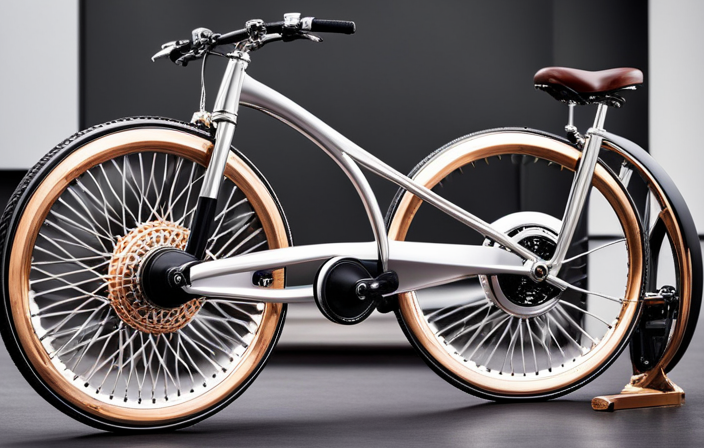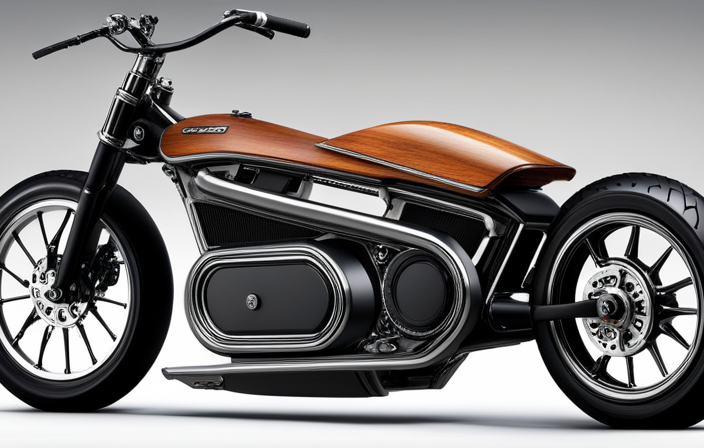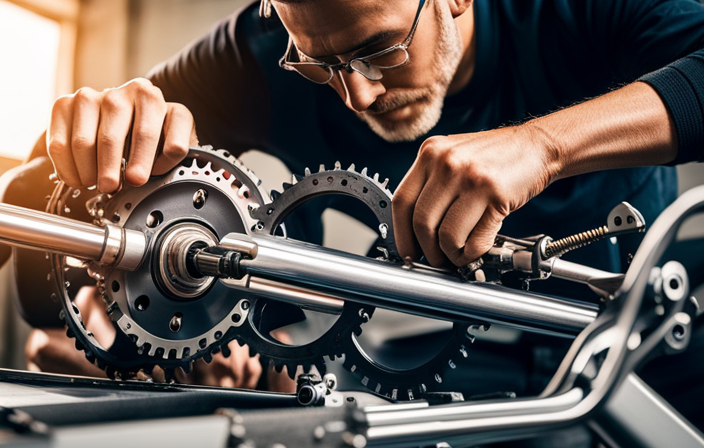Have you ever wanted to transform your regular bike into an electric bike? Look no further! In this article, we will guide you through the process of making your bike electric, step by step.
From assessing your bike’s compatibility to choosing the right conversion kit and installing the electric motor, we’ve got you covered.
Get ready to enjoy the thrill of riding an upgraded electric bike while saving money and reducing your carbon footprint.
Let’s dive in!
Key Takeaways
- Troubleshooting and testing the electric system is crucial for pedal assist issues and ensuring proper functioning.
- Properly connecting and reinstalling bike components, following wiring diagrams and color-coding, is essential for a successful electric bike conversion.
- Ensuring safety measures such as wearing a helmet, using reflective gear, and familiarizing with electric bike laws is important for safe riding.
- Regular maintenance and servicing of the electric bike, including checking and cleaning components, is necessary for optimal performance and longevity.
Assess Your Bike’s Compatibility
You’ll need to assess if your bike is compatible with being converted into an electric bike. To evaluate compatibility, start by looking at the frame of your bike. It should be sturdy enough to handle the extra weight of the electric components. Additionally, check if there is enough space to accommodate the battery and motor.
Next, examine the fork and rear dropouts to ensure they can support the necessary modifications. You may need to make adjustments or potentially replace these parts if they are not suitable.
Another important factor to consider is the braking system. Make sure it is strong enough to handle the increased speed and weight of the electric bike.
Once you have evaluated compatibility and made any necessary modifications, you can move on to choosing the right conversion kit.
Choose the Right Conversion Kit
Selecting the appropriate conversion kit will help you transform your bicycle into an e-bike. To ensure you make an informed decision, there are a few key factors to consider.
-
Price considerations: Determine your budget and explore conversion kits that offer the best value for your money. Remember that higher-priced kits often come with more advanced features and better quality components.
-
Battery range options: Assess your riding needs and choose a conversion kit that provides the desired battery range. Consider factors like your daily commute distance or the length of your recreational rides. Look for kits that offer different battery capacity options to meet your specific requirements.
-
Compatibility: Ensure that the conversion kit you choose is compatible with your bike’s frame, wheel size, and brake system. Some kits are designed for specific bike types, so check the manufacturer’s guidelines to verify compatibility.
-
Ease of installation: Look for conversion kits that come with detailed instructions and all the necessary hardware. Additionally, consider your own mechanical skills and choose a kit that matches your comfort level for installation.
By considering these factors, you can confidently select the right conversion kit for your bike. Once you’ve made your choice, it’s time to gather the necessary tools for the installation process.
Gather the Necessary Tools
Before starting the installation process, gather all the tools required for the job. Assessing compatibility and choosing the right conversion kit are crucial steps in converting your bike into an electric bike. To make this process easier, I have compiled a table below that lists the necessary tools you will need:
| Tools | Quantity | Purpose |
|---|---|---|
| Wrench set | 1 | To remove and install bike components |
| Screwdriver set | 1 | For adjusting and securing parts |
| Allen key set | 1 | To tighten bolts and screws |
| Wire cutters | 1 | For cutting and stripping wires |
| Multimeter | 1 | To measure electrical values |
Having these tools on hand will ensure a smooth and efficient installation process. Once you have gathered all the necessary tools, you can proceed to the next step of removing the bike’s existing components.
Remove the Bike’s Existing Components
To begin the conversion process, it’s important to remove the existing components from your bicycle. Assess the compatibility of your bike with an electric conversion kit. Not all bikes are suitable for conversion, so it’s crucial to choose the right kit for your specific bike model and size.
Start by removing the pedals and crankset using a pedal wrench and crank puller. Next, take off the front and rear wheels by loosening the quick-release levers or using a wrench to unscrew the nuts. Remove the chain by breaking it with a chain tool, and detach the derailleur and rear cassette using the appropriate tools.
Finally, disconnect the brake cables and remove the handlebars and stem. With all the existing components removed, you can now move on to the next step of installing the electric motor.
Install the Electric Motor
Now it’s time to install the electric motor onto your bicycle. When it comes to electric motor installation, there are a few tips that can help ensure a successful process.
First, make sure you have the necessary tools, including wrenches, screwdrivers, and zip ties.
Begin by attaching the motor to the bike frame using the mounting brackets provided. Ensure that it is securely fastened to prevent any movement during operation.
Next, connect the motor to the bike’s drivetrain using a chain or belt drive system. This will allow the motor to transfer power to the wheels.
Troubleshooting common motor installation issues may include checking for loose connections, ensuring proper alignment, and adjusting tension.
Once the motor is installed, you can now move on to the next step of connecting the battery and controller, which will provide power to the motor and regulate its functions.
Connect the Battery and Controller
Once you have completed the installation of the electric motor, it’s time to connect the battery and controller. This step is crucial as it powers your electric bike and allows you to control its speed and other functions. Here’s what you need to do:
-
Troubleshooting common connection issues: Before connecting the battery and controller, ensure that all wires are properly connected and secure. Check for any loose connections or damaged wires that may hinder the functioning of your electric bike.
-
Upgrading to a higher capacity battery: If you want more power and longer range for your electric bike, consider upgrading to a higher capacity battery. This will provide you with improved performance and allow you to tackle longer rides without worrying about running out of power.
-
Once you have successfully connected the battery and controller, you can now proceed to mount the throttle and display, which will enable you to control the speed and monitor important information about your electric bike’s performance.
Mount the Throttle and Display
Attach the throttle and display to control your speed and monitor important information about your e-bike’s performance.
Installing the throttle and display is a crucial step in converting your bike into an electric one. First, locate the appropriate place on your handlebar to mount the throttle. Make sure it is easily accessible and within reach of your thumb.
Next, connect the throttle wires to the controller, ensuring a secure connection. As for the display, find a suitable spot on your handlebar where it can be easily seen while riding. Connect the display to the controller, making sure all the wires are properly inserted.
Troubleshooting common electric bike conversion issues may arise during this process, such as loose connections or faulty wiring. Double-check all connections and consult the instruction manual if needed.
Once the throttle and display are securely installed, you can proceed to the next step of installing the pedal assist sensor, which will enhance your riding experience.
Install the Pedal Assist Sensor
To install the pedal assist sensor, you’ll need to position it on your bike’s crank arm and ensure it is securely attached.
The pedal assist sensor is a crucial component of an electric bike, as it detects the rotational movement of the pedals and sends a signal to the motor to provide assistance. By installing the pedal assist sensor, you can enjoy the benefits of pedal assist, which include a smoother and more natural riding experience, increased efficiency, and extended battery life.
However, if you encounter any issues with the pedal assist, such as the sensor not responding or providing inconsistent assistance, there are a few troubleshooting steps you can take. These include checking the wiring connections, ensuring the sensor is properly aligned, and adjusting the sensitivity settings if necessary.
Moving on to the next section, let’s now connect the wiring to complete the installation process.
Connect the Wiring
Now it’s time to connect the wiring to complete the installation process. Proper wiring connections are essential for an electric bike to function smoothly and efficiently. Here are the steps to ensure a successful wiring setup:
-
Check the wiring diagram: Before connecting any wires, refer to the wiring diagram provided by the manufacturer. This will give you a clear understanding of which wires go where.
-
Secure the connectors: Match the connectors from the motor, battery, and controller. Ensure they are securely connected, using zip ties or electrical tape to keep them in place.
-
Battery connections: Connect the positive and negative terminals of the battery to the corresponding terminals on the controller.
-
Motor connections: Connect the motor wires to the appropriate terminals on the controller, following the color-coding or labeling.
Troubleshooting common wiring issues in electric bikes may include checking for loose connections, damaged wires, or blown fuses. Once the wiring is properly connected, we can move on to the next step of testing and adjusting the electric system.
Test and Adjust the Electric System
First, you should make sure to properly test and adjust the electric system for optimal performance. Adjusting the electric system is crucial to ensure that your electric bike functions smoothly. Start by checking the wiring connections and ensuring that they are secure. Next, test the battery to make sure it is holding a charge and delivering power to the motor. Troubleshooting common electric system issues is also important. If you encounter problems such as a weak motor, check the voltage output of the battery and adjust it if necessary. Additionally, make sure the throttle, brakes, and other components are properly calibrated. By thoroughly testing and adjusting the electric system, you can ensure that your electric bike operates at its best. Now, let’s move on to the next section and discuss how to reinstall the bike’s components.
Reinstall the Bike’s Components
Once you have finished testing and adjusting the electric system, you can proceed to reinstalling all the components of your bike.
Start by gathering all the parts that you have removed during the installation process.
Begin with the handlebars, ensuring that they are securely fastened and aligned.
Attach the front brake and gear shifters, making sure they are properly connected and functioning smoothly.
Next, reinstall the front wheel by aligning the axle with the fork dropouts and tightening the nuts or quick release lever.
Secure the seat post and saddle, ensuring it is at the appropriate height for comfortable riding.
Finally, reinstall the pedals, making sure they are tightened securely.
Troubleshooting common installation issues such as loose connections or misaligned components is crucial to ensure the proper functioning of your electric bike.
With all the components reinstalled, you can now move on to the next section, where we will discuss how to ensure proper safety measures without compromising your riding experience.
Ensure Proper Safety Measures
To ensure a safe riding experience, it is important to implement proper safety measures. Safety precautions are essential when converting a bike into an electric bike. Not only do these precautions protect the rider, but they also ensure the longevity and efficiency of the bike. One of the main benefits of electric bikes is their ability to provide assistance when climbing hills or traveling long distances. However, this added power also increases the risk of accidents if not handled correctly. Therefore, it is crucial to wear a helmet, use reflective gear, and install proper lighting to increase visibility. Additionally, it is important to familiarize yourself with electric bike laws to ensure compliance and avoid any legal issues. By following these safety measures, you can enjoy the benefits of an electric bike while riding responsibly. Now, let’s move on to the next section and familiarize yourself with electric bike laws.
Familiarize Yourself with Electric Bike Laws
You should familiarize yourself with the laws regarding electric bikes. Understanding the legal requirements is crucial to ensure that you are riding your electric bike within the boundaries of the law. Here are the key things you need to know:
-
Check the maximum speed limit: Different jurisdictions have different speed limits for electric bikes, typically ranging from 20 to 28 mph.
-
Know the power limit: Electric bikes usually have power restrictions, often limited to 750 watts. Make sure your electric bike conversion kit complies with these regulations.
-
Understand age restrictions: Some areas have age restrictions for riding electric bikes. Ensure you meet the minimum age requirement before getting on the road.
-
Find the best electric bike conversion kit: Look for conversion kits that are compliant with local regulations and provide a smooth and efficient transition to an electric bike.
By understanding the legal requirements and finding the best electric bike conversion kit, you can confidently ride your electric bike within the boundaries of the law.
Now, let’s delve into how to maintain and service your electric bike.
Maintain and Service Your Electric Bike
Now that you are familiar with electric bike laws, it’s time to shift our focus to maintaining and servicing your electric bike.
Proper electric bike maintenance is crucial for the longevity and optimal performance of your bike. Regularly check and clean your bike’s components, such as the chain, brakes, and tires, to ensure they are in good condition.
Additionally, pay attention to the battery, as it is the heart of your electric bike. Keep it charged and store it properly when not in use.
Troubleshooting common issues like a faulty motor or a malfunctioning display can be done by referring to the manufacturer’s manual or seeking professional help.
By maintaining and servicing your electric bike, you can enjoy a seamless and efficient ride.
So, let’s dive into the next section and learn how to enjoy your upgraded electric bike experience!
Enjoy Your Upgraded Electric Bike Experience!
Experience the thrill of riding your upgraded electric bike and enjoy the enhanced performance it offers! Upgrading your bike with an electric motor can completely transform your riding experience.
Here are the benefits of electric bike conversion kits:
-
Increased speed: With an electric motor, you can effortlessly reach higher speeds, making your commute faster and more efficient.
-
Improved range: Electric bike conversion kits provide you with a longer range, allowing you to explore farther distances without worrying about running out of battery.
-
Enhanced power: The added electric motor gives you extra power when climbing hills or tackling rough terrains, making your rides smoother and more enjoyable.
-
Eco-friendly transportation: By converting your bike into an electric one, you contribute to reducing carbon emissions and promoting sustainable transportation.
Upgrade your bike with an electric motor and unlock a whole new level of biking experience. Enjoy the benefits of increased speed, improved range, enhanced power, and eco-friendly transportation!
Frequently Asked Questions
How long does it typically take to convert a bike into an electric bike?
On average, converting a bike into an electric bike takes around 4 to 6 hours. However, the actual time may vary depending on your expertise and the complexity of the conversion.
Common challenges include finding the right components, ensuring proper electrical connections, and adjusting the bike’s frame to accommodate the added weight of the electric motor and battery.
It is important to carefully follow the instructions provided with your conversion kit to ensure a successful and safe conversion.
What is the average cost of a conversion kit?
The average cost of a conversion kit for turning a regular bike into an electric bike can vary depending on the type of kit you choose. There are different types of conversion kits available in the market such as front wheel, rear wheel, and mid-drive kits.
On average, these kits can range from $200 to $1000. It is important to consider factors such as power, battery capacity, and brand reputation when selecting a kit.
Can any bike be converted into an electric bike?
Absolutely! Any bike can be converted into an electric bike, regardless of its make or model. The key lies in finding the right conversion kit that suits your bike’s compatibility.
Electric bike conversion offers numerous benefits like increased speed, extended range, and reduced effort while cycling. It’s a cost-effective solution that allows you to transform your ordinary bike into a powerful electric one, enhancing your overall riding experience.
Are there any weight restrictions for the bike when adding an electric motor?
When adding an electric motor to a bike, it is crucial to consider weight restrictions. The weight limit for an electric bike depends on the type and power of the motor.
It is essential to choose a motor that is suitable for your bike’s weight and intended usage. A higher-powered motor may be needed for heavier bikes or riders.
Consulting with an expert or referring to the motor’s specifications can help you choose the right motor for your bike.
Are there any special maintenance requirements for an electric bike compared to a regular bike?
Maintenance tips for electric bikes include:
-
Regularly cleaning the bike to prevent dirt build-up, especially around the motor and battery areas.
-
Inspecting the tires, brakes, and chain for wear and tear, and adjusting or replacing them as needed.
-
Keeping the battery charged and stored in a cool, dry place when not in use.
-
Looking out for common problems such as loose connections, faulty wiring, and water damage, which may require professional repair.
Conclusion
Congratulations on successfully transforming your regular bike into an electrifying ride!
With careful assessment, the right conversion kit, and the proper tools, you’ve taken a leap into the future of biking.
By following safety measures, familiarizing yourself with electric bike laws, and maintaining your new electric bike, you’ve ensured a smooth and enjoyable journey every time you hit the road.
Now, get ready to experience the thrill of speed and the convenience of electric power like never before.
Get ready to conquer the streets with your upgraded electric bike!









